Life in the Time of Sailing Ships - Part II by Jayne Davis #History #Ships #Regency @jaynedavis142
Life in the Time of Sailing Ships - Part II By Jayne Davis
In Part I of Life in the Time of Sailing Ships I looked at some phrases in everyday language that originated in the days of sail. A couple of comments were words to the effect of ‘How did so many men live on that?!’So this post is about how the sailors lived on a ship of the line such as HMS Victory, or a frigate such as HMS Trincomalee. Officers shared small cabins, but the facilities for the ratings were much less civilised. The photos here are from my visits to the two ships mentioned.
How many men… and women?
HMS Victory was a first-rate ship of the line, meaning it had over 100 guns, and a crew of around 850 men. HMS Trincomalee had 39 guns and a crew of around 350. The crew numbers given are the number of men and boys officially on the ship’s books, but many women went to sea as well. Their presence was tolerated, not official, and so they do not appear on the official records. They acted as seamstresses, tended the sick, or helped the powder monkeys (boys who carried charges of gunpowder from the powder store to the gunners).
Sleeping
Officers (and any wives or loose women they had) slept in cots, with a degree of privacy—the more senior had larger quarters, and on a flagship like Victory, there would not only be a large cabin with stern windows for the ship’s captain, but similarly impressive quarters above that for the Admiral.
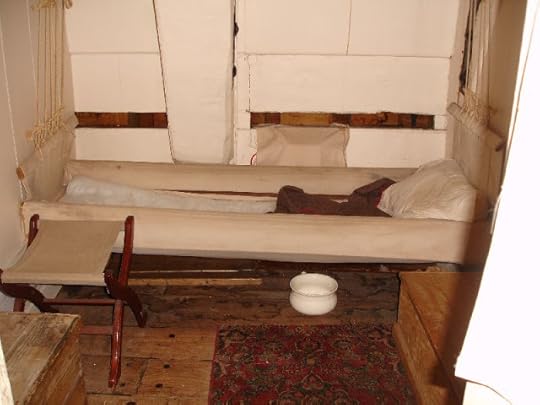 An officer’s cabin on HMS Trincomalee.
An officer’s cabin on HMS Trincomalee.The ratings were not so lucky. They slept on one of the gun decks. As you can see in the photo below, the guns take up a fair amount of space. In this image the guns are ‘run out’, with the ends sticking out through the gun ports as they would be when ready to fire. When the ship was not cleared for action, the guns would be completely inside the ship with the gun ports closed to keep spray out. Not only did this leave less space on the deck, but also reduced the light and ventilation.
 A gun deck on the Victory, ready for action, with a tourist for scale.
A gun deck on the Victory, ready for action, with a tourist for scale.So where did the men sleep? In hammocks, slung from the beams above the guns.
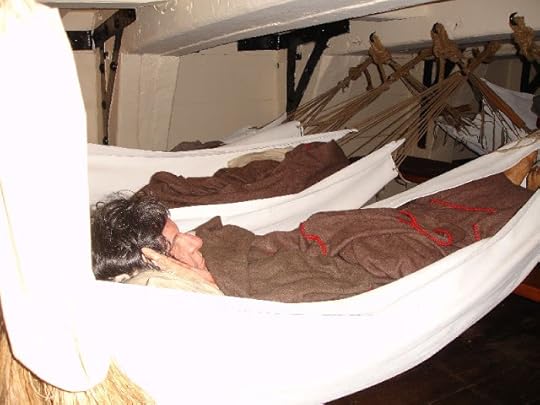 Hammocks slung on HMS Trincomalee.
Hammocks slung on HMS Trincomalee.At sea, most sailors got only 4 hours’ sleep a night. The crew of a ship was divided into two watches, apart from the Captain and some of the warrant officers such as the purser or carpenter. At sea, there would always be one watch on duty, ready to handle the ship. One watch would sling their hammocks and sleep from 8 until midnight, then the other watch would sleep until 4 in the morning. From then on, both watches were awake until 8 the following evening. When the hammocks were not being used, they were rolled up into long sausage shapes with a waterproof cover, and stowed in the nettings along the edges of the upper decks.
 Netting on HMS Victory. The bagged hammocks were stored between the two lines of netting, and provided some protection against musket or pistol fire in action.
Netting on HMS Victory. The bagged hammocks were stored between the two lines of netting, and provided some protection against musket or pistol fire in action.Storage of possessions was also a problem. A sailor with only a few possessions could roll up spare clothing and small items inside his hammock, but a man with a sea chest would have to stow it on a lower deck during the day.You might have got better sleeping accommodation if you were ill. The Sick Bay on HMS Victory isn’t large, but includes some cots. It is on a higher gundeck than the main sleeping accommodation, allowing more light and air, and also means men with contagious diseases could be kept separate from the rest of the crew. But as with most things on a warship, the guns were the most important thing – the contents of the sick bay would be moved elsewhere if the ship went into action.
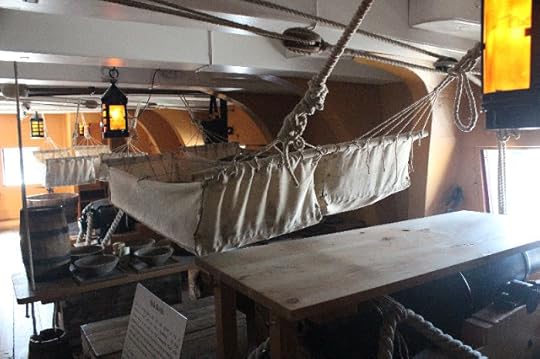 The Sick Bay on HMS Victory with cots slung from the ceiling. Note the table in the foreground, mounted on one of the guns.
The Sick Bay on HMS Victory with cots slung from the ceiling. Note the table in the foreground, mounted on one of the guns.Eating Officers dined in the wardroom, on a proper table. If you visit HMS Victory, you can see a long mess table of polished wood, set out with glasses and fine china. Officers who could afford extras did not stint themselves.However even they could not always avoid the guns. The larger cabins often contained one or two guns, and were divided from each other by removable partitions which were taken down when the ship went into action.
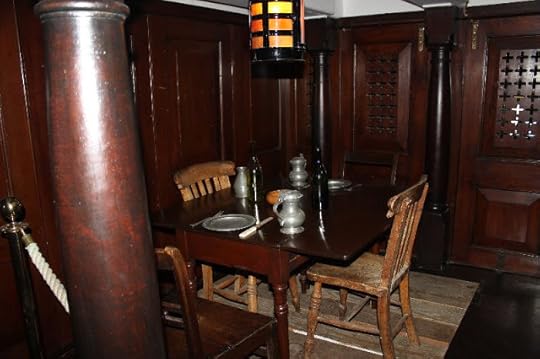 An officers’ dining area on HMS Victory
An officers’ dining area on HMS VictoryThe men ate on tables between the guns, suspended from the ceiling, or sometimes just had to sit on their sea chests.
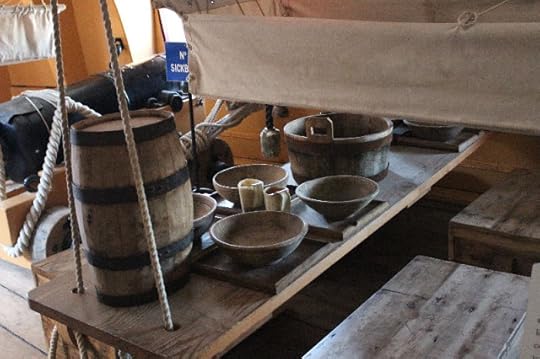 A table a ‘mess’ of six men on Victory. This one is in the sick bay, hence the cot hanging above it. Note the gun on the left.
A table a ‘mess’ of six men on Victory. This one is in the sick bay, hence the cot hanging above it. Note the gun on the left.The ‘heads’And the question that most kids (and some adults) ask is, how did they go to the loo? Again, rank comes into this. Officers had small private rooms, with the kind of toilet that consists of a plank with a hole in it to sit on, with a container underneath that could be emptied.Other ranks used the heads. Toilets on ships today are still referred to as heads, as in ‘I’m going to the head’. This comes from the location of toilets in sailing ships at the head, or front, of the ship. Not only were they at the front, but they were outdoors, allowing waste to fall directly into the sea.
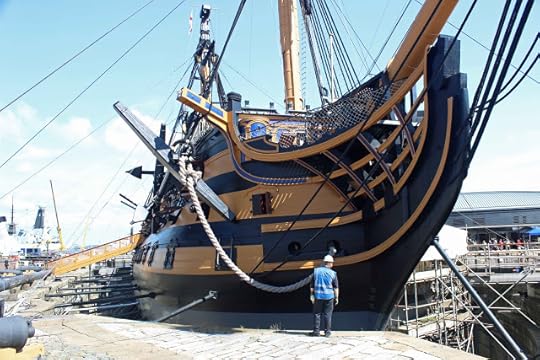 The bows of HMS Victory. The area behind the netting at the top would have had seats with holes, allowing waste to drop down through the open structure beneath it.
The bows of HMS Victory. The area behind the netting at the top would have had seats with holes, allowing waste to drop down through the open structure beneath it.Further reading:
The Wooden World, by N A M Rodger, is an excellent history of the Georgian Navy, and the source of many of the details in this article.
The Mrs MacKinnons

England, 1799Major Matthew Southam returns from India, hoping to put the trauma of war behind him and forget his past. Instead, he finds a derelict estate and a family who wish he'd died abroad.Charlotte MacKinnon married without love to avoid her father’s unpleasant choice of husband. Now a widow with a young son, she lives in a small Cotswold village with only the money she earns by her writing.Matthew is haunted by his past, and Charlotte is fearful of her father’s renewed meddling in her future. After a disastrous first meeting, can they help each other find happiness?4.7* average on Amazon, available on Kindle Unlimited.
Amazon
Jayne Davis
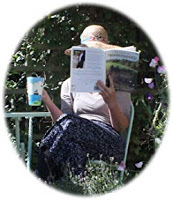 Jayne Davis writes historical romances set in the late Georgian/Regency era, published as both ebooks and paperbacks.She was hooked on Jane Austen and Georgette Heyer as a teenager, and longed to write similar novels herself. Real life intervened, and she had several careers, including as a non-fiction author under another name. That wasn't quite the writing career she had in mind...Finally, she got around to polishing up stories written for her own amusement in long winter evenings, and became the kind of author she’d dreamed of in her teens. She is now working on the first few books in the Marstone Series, set in the late Georgian/early Regency period.
Jayne Davis writes historical romances set in the late Georgian/Regency era, published as both ebooks and paperbacks.She was hooked on Jane Austen and Georgette Heyer as a teenager, and longed to write similar novels herself. Real life intervened, and she had several careers, including as a non-fiction author under another name. That wasn't quite the writing career she had in mind...Finally, she got around to polishing up stories written for her own amusement in long winter evenings, and became the kind of author she’d dreamed of in her teens. She is now working on the first few books in the Marstone Series, set in the late Georgian/early Regency period.You can find Jayne: Website • Blog • Pinterest.
Published on November 20, 2018 23:00
No comments have been added yet.
The Coffee Pot Book Club
The Coffee Pot Book Club (formally Myths, Legends, Books, and Coffee Pots) was founded in 2015. Our goal was to create a platform that would help Historical Fiction, Historical Romance and Historical
The Coffee Pot Book Club (formally Myths, Legends, Books, and Coffee Pots) was founded in 2015. Our goal was to create a platform that would help Historical Fiction, Historical Romance and Historical Fantasy authors promote their books and find that sometimes elusive audience. The Coffee Pot Book Club soon became the place for readers to meet new authors (both traditionally published and independently) and discover their fabulous books.
...more
...more
- Mary Anne Yarde's profile
- 159 followers



